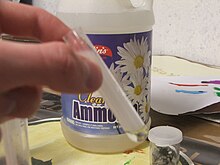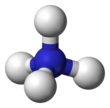|
Ammonia solution
Ammonia solution, also known as ammonia water, ammonium hydroxide, ammoniacal liquor, ammonia liquor, aqua ammonia, aqueous ammonia, or (inaccurately) ammonia, is a solution of ammonia in water. It can be denoted by the symbols NH3(aq). Although the name ammonium hydroxide suggests a salt with the composition [NH+ The concentration of such solutions is measured in units of the Baumé scale (density), with 26 degrees Baumé (about 30% of ammonia by weight at 15.5 °C or 59.9 °F) being the typical high-concentration commercial product.[7] Basicity of ammonia in waterIn aqueous solution, ammonia deprotonates a small fraction of the water to give ammonium and hydroxide according to the following equilibrium:
In a 1 M ammonia solution, about 0.42% of the ammonia is converted to ammonium, equivalent to pH = 11.63
because [NH+
Saturated solutionsLike other gases, ammonia exhibits decreasing solubility in solvent liquids as the temperature of the solvent increases. Ammonia solutions decrease in density as the concentration of dissolved ammonia increases. At 15.6 °C (60.1 °F), the density of a saturated solution is 0.88 g/ml; it contains 35.6% ammonia by mass, 308 grams of ammonia per litre of solution, and has a molarity of approximately 18 mol/L. At higher temperatures, the molarity of the saturated solution decreases and the density increases.[8] Upon warming of saturated solutions, ammonia gas is released. ApplicationsIn contrast to anhydrous ammonia, aqueous ammonia finds few non-niche uses outside of cleaning agents. Cleaning products
 Ammonia solutions are used as a cleaning products for many surfaces and applications. Ammonia in water is sold as a cleaning agent by itself, usually labeled as simply "ammonia", as well as in cleaning products combined with other ingredients. It may be sold plain, lemon-scented (and typically colored yellow), or pine-scented (green). Commonly available ammonia with soap added is known as "cloudy ammonia". Household ammonia ranges in concentration by weight from 5% to 10% ammonia.[9] Because aqueous ammonia is a gas dissolved in water, as the water evaporates from a surface, the gas evaporates also, leaving the surface streak-free. Its most common uses are to clean glass[10] , porcelain, and stainless steel. It is good at removing grease and is found in products for cleaning ovens and for soaking items to loosen baked-on grime. Experts also warn not to use ammonia-based cleaners on car touchscreens, due to the risk of damage to the screen's anti-glare and anti-fingerprint coatings.[11] More concentrated solutions (higher than 10%) are used for in professional and industrial cleaning products. US manufacturers of cleaning products are required to provide the product's material safety data sheet that lists the concentration used.[12] Solutions of ammonia can be dangerous. These solutions are irritating to the eyes and mucous membranes (respiratory and digestive tracts), and to a lesser extent the skin. Experts advise that caution be used to ensure the chemical is not mixed into any liquid containing bleach, due to the danger of forming toxic chloramine gas. Mixing with chlorine-containing products or strong oxidants, such as household bleach, can generate toxic chloramine fumes.[13] Alkyl amine precursorIn industry, aqueous ammonia can be used as a precursor to some alkyl amines, although anhydrous ammonia is usually preferred. Hexamethylenetetramine forms readily from aqueous ammonia and formaldehyde. Ethylenediamine forms from 1,2-dichloroethane and aqueous ammonia.[14] Absorption refrigerationIn the early years of the twentieth century, the vapor absorption cycle using water-ammonia systems was popular and widely used, but after the development of the vapor compression cycle it lost much of its importance because of its low coefficient of performance (about one fifth of that of the vapor compression cycle). Both the Electrolux refrigerator[15] and the Einstein refrigerator are well known examples of this application of the ammonia solution. Water treatmentAmmonia is used to produce chloramine, which may be utilised as a disinfectant.[16] In drinking water, chloramine is preferred over direct chlorination for its ability to remain active in stagnant water pipes longer, thereby reducing the risk of waterborne infections. Ammonia is used by aquarists for the purposes of setting up a new fish tank using an ammonia process called fishless cycling.[17] This application requires that the ammonia contain no additives. Food productionBaking ammonia (ammonium carbonate and ammonium bicarbonate) was one of the original chemical leavening agents. It was obtained from deer antlers.[18] It is useful as a leavening agent, because ammonium carbonate is heat activated. This characteristic allows bakers to avoid both yeast's long proofing time and the quick CO2 dissipation of baking soda in making breads and cookies rise. It is still used to make ammonia cookies and other crisp baked goods, but its popularity has waned because of ammonia's off-putting smell and concerns over its use as a food ingredient compared to modern-day baking powder formulations. It has been assigned E number E527 for use as a food additive in the European Union. Aqueous ammonia is used as an acidity regulator to bring down the acid levels in food. It is classified in the United States by the Food and Drug Administration as generally recognized as safe (GRAS) when using the food grade version.[19] Its pH control abilities make it an effective antimicrobial agent. Furniture darkeningIn furniture-making, ammonia fuming was traditionally used to darken or stain wood containing tannic acid. After being sealed inside a container with the wood, fumes from the ammonia solution react with the tannic acid and iron salts naturally found in wood, creating a rich, dark stained look to the wood. This technique was commonly used during the Arts and Crafts movement in furniture – a furniture style which was primarily constructed of oak and stained using these methods.[20] Treatment of straw for cattleAmmonia solution is used to treat straw, producing "ammoniated straw" making it more edible for cattle.[21] Laboratory useAqueous ammonia is used in traditional qualitative inorganic analysis as a complexant and base. Like many amines, it gives a deep blue coloration with copper(II) solutions. Ammonia solution can dissolve silver oxide residues, such as those formed from Tollens' reagent. It is often found in solutions used to clean gold, silver, and platinum jewelry, but may have adverse effects on porous gem stones like opals and pearls.[22] See alsoReferences
Further reading
External links
|
||||||||||||||||||||||||||||||||||||||||||||||||||||||||||||||||||||||||||||||||||||||||||||||||||||||||||||








